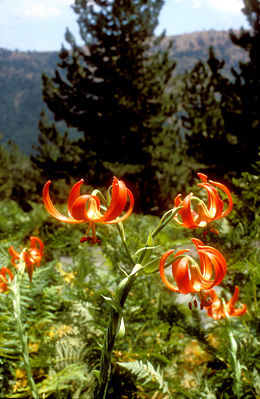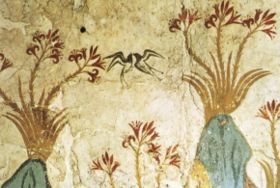- Lilium chalcedonicum
-
Chalzedonische Lilie Systematik Unterklasse: Lilienähnliche (Liliidae) Ordnung: Lilienartige (Liliales) Familie: Liliengewächse (Liliaceae) Unterfamilie: Lilioideae Gattung: Lilien (Lilium) Art: Chalzedonische Lilie Wissenschaftlicher Name Lilium chalcedonicum L. Die Chalzedonische Lilie (Lilium chalcedonicum) ist eine Art aus der Gattung der Lilien (Lilium) in der Candidum-Sektion.
Inhaltsverzeichnis
Beschreibung
Die Chalzedonische Lilie ist eine mehrjährige krautige Pflanze, die in der Regel Wuchshöhen von 35 bis 70 Zentimeter erreicht [1]. Die Zwiebel ist weiß-gelblich und breit. Die Pflanze bildet ab dem Frühjahr einen dicht mit schmalen, lanzettförmigen, nach oben hin kürzer werdenden Blättern besetzten Stängel. Das zerstreut stehende Blattwerk steht am Ansatz fast waagerecht, zum oberen Ende hin jedoch immer mehr aufrecht, bis die Blätter fast am Stängel anliegen. [2]
An ihm erscheint im Juli bis August eine Rispe mit ein bis vier (selten bis zwölf) stark zurückgebogenen, zinnoberroten Blüten, die am Ansatz stark papillös sind. Der Pollen ist tiefrotorange. Der Samen keimt verzögert-epigäisch [2]. [1]
Verbreitung
Die Chalzedonische Lilie ist nur in Süd-Albanien, Griechenland und den Ionischen Inseln beheimatet. Sie gedeiht an leicht feuchten, halbschattigen Standorten in offenen Laubwäldern, Buchsbaum-Strauchwerk und Wiesen auf kalkhaltigem, felsigem Untergrund zwischen 600 und 1700 Meter Höhenlage. [1]
Systematik
Die Chalzedonische Lilie wurde 1753 von Carl von Linné erstbeschrieben. Zeitweise wurden neben der Nominatform die Varietäten Lilium chalcedonicum var. maculatum (mit dicht schwarzgepunkteter Blüte) sowie Lilium chalcedonicum var. heldreichii (am oberen Teil des Stängels unbehaart) geführt [2]. Sie werden jedoch beide heute nicht mehr anerkannt [1].
Lilium chalcedonicum kann mit der Madonnenlilie (Lilium candidum) die Naturhybride Lilium x testaceum bilden [2].
Kultur
Die älteste bekannte Darstellung einer Lilie zeigt vermutlich Chalzedonische Lilien. Es handelt sich dabei um ca. 3500 Jahre alte Fresken in der bronzezeitlichen Stadt Akrotiri auf der griechischen Insel Santorin, die bei der Minoischen Eruption durch einen Vulkan verschüttet wurde. [3]
Wegen ihres spektakulären Erscheinungsbildes wird sie mindestens seit dem 16. Jahrhundert kultiviert [1]. Sie wurde angeblich durch Master Harbran 1597 aus Konstantinopel nach Europa gebracht. [2]
Einzelnachweise
- ↑ a b c d e Arne Strid: The lilies of Greece. In: Caroline Boisset (Hrsg.): Lilies And Related Plants, 2007, S.18-26, ISBN 9781902896847
- ↑ a b c d e Carl Feldmaier, Judith McRae: Lilien. Ulmer, Stuttgart 1982, ISBN 3-80016-121-4
- ↑ Thera Foundation: Spring Fresco – Beschreibung und Interpretation der Frühlingsfresken in Akrotiri (englisch)
Wikimedia Foundation.


